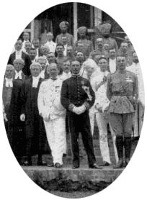The Rt. Hon. CHARLES KENNETH DAIN C.B.E

The Rt. Hon. CHARLES KENNETH DAIN C.B.E. (centre of picture) and his wife bought 58 and 56 Town Hill in 1923, this being one property. It was their home until 1956. Before retirement he was Treasurer of Uganda at Entebbe, President of the Tender Board and Controller of Savings. He was awarded a C.B.E. in 1927. He was responsible for advising the British Government on all financial matters related to the British Protectorate of Uganda. After independence, Dictator Idi Amin expelled 60,000 Asians. Many thousands of people were killed in ethnic cleansing. West Malling housed many Ugandan Asians.
Town Hill Cottage 58 and Top Hill House 56, Town Hill are Grade 2 Listed Buildings. Town Hill Cottage (No 58) was originally a detached, 16th century half-hipped house, of earlier origin with considerable surrounding land and outbuildings. In the late 18th century Top Hill House (No 56) was built as an extension to No 58 by the Martin family. Circa 1900 the property was bought by the Nevill (Earl Abergavenny) family becoming part of their Lantern Estate opposite, with Lady Agnew in residence until c.1920.
Dain and his wife bought 58 and 56 Town Hill in 1923 this being one property. It was their home until 1956. The Hon. Dain, before retirement, was Treasurer, Controller of Savings and President of the Tender Board of Uganda at Entebbe. Responsibilities included the acquisition and disposal of Government assets. He was awarded a CBE in 1927.
JH Speke explored Uganda in 1862 it came under British Protection in 1894. Competing factions were eventually stabilised by skilful diplomacy, successful social improvements and a new Maxim Gun. The white population in 1909 was 507 with 3000 mainly British Asians. Native peoples comprised mainly three ethnic groups. The native states had home rule. Good roads, a railway, schools and medical facilities were built. An agricultural economy was successfully developed.
From 1904 cotton was grown by the native peoples and processed by Indians. In 1958 Internal self-government was established, and in 1962 Uganda was given independence with Milton Obote as Prime Minister. In 1971 Milton Obote, then president, was toppled by a military Coup led by Dictator Idi Amin. In 1972 Amin ordered 60,000 Asians to leave. During the violent ethnic cleansing and Africanisation many thousands of people died. Many Ugandan Asians came to Britain. A large group were housed in West Malling on the site of the Old Workhouse.
Town Hill Cottage 58 and Top Hill House 56 Town Hill.
Grade 2 Listed Buildings. Town Hill Cottage (No 58) was originally a detached, 16th century. half-hipped house of earlier origin with considerable surrounding land and outbuildings. In 1789 Edward Martin and his French wife bought the house and land from Alexander Puxty who inherited from his Grandfather (also called Alexander Puxty). The Martin family had leased it for a considerable time. Prior to this records show ownership by Staples preceded by Bovey. A fashionable brick façade and rear extension had been built early in the 18th century.
In the late 18th century. Edward Martin built the three story house adjoining No 58 called Top Hill House as an extension to No 58. In 1866 Earl Abergavenny bought the Mansion opposite called Lantern House (aka Malling House) from the heirs of Valentine Phillips (one of these being the owner of the famous Auction House of Phillips). In 1901 a member of Abergavenney’s family bought No 58 and No 56 Town Hill which was then one house. This was occupied by Lady Agnew until 1920 about which time the Nevill (Abergavenny) estate was divided.
Charles Kenneth Dain and his wife bought the house and lived here until 1956. The house was divided on their death and most of the surrounding land and part of the house gifted to their helpers.
Ashford & Tenterden Canterbury, Herne Bay and Whitstable Dover, Deal & Sandwich Faversham, Isle of Sheppey and Sittingbourne Folkestone, Hythe & Romney Marsh Gravesend & Dartford Maidstone Margate, Broadstairs & Ramsgate Rochester, Chatham & Gillingham Sevenoaks Tonbridge and Malling Tunbridge Wells






